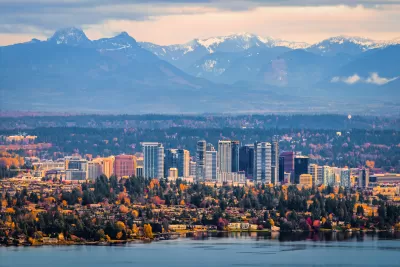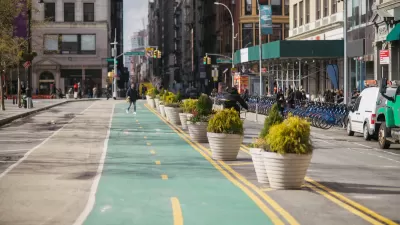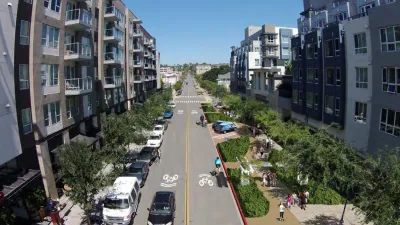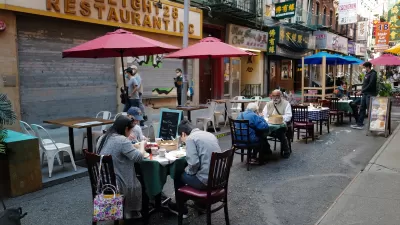The plan reorients the city’s priorities from vehicle throughput and parking to transit, bike infrastructure, and other public amenities.

The city of Bellevue, Washington wants to create a consistent set of rules governing curbside space, reports Ryan Packer in The Urbanist, with a focus on shifting away from single-occupancy vehicle movement and storage through a new Curb Management Plan. “In the works since early 2022, the plan has been molded and shaped over many months of outreach and years of work to provide city leaders a toolkit for how to move forward with rethinking how those valuable spaces function to achieve broader city goals, like improved safety, vibrancy, and increased transit ridership.”
Packer explains that, currently, just 3 percent of Bellevue’s curb space is dedicated to loading zones, bus stops, or transit lanes. 60 percent of curb space is used for vehicle throughput, Packer adds. “Having fast-moving traffic directly next to pedestrian traffic also provides no buffer, impacting the city’s safety goals.”
The plan puts in motion a series of pilot programs, including one that would promote parking in off-street stalls and another that would study the potential for on-street loading. “All of these will be happening against the backdrop of the continued expansion of the city’s bike network along growth corridors near coming light rail stations, a plan being called Bike Bellevue.”
The article quotes Christopher Randels, chair of Complete Streets Bellevue, saying, “I hope that this framework, by creating more spaces that are not devoted to automobile traffic… starts to change the culture of the city in a way that pedestrians, cyclists are more visible, they’re more seen as a part of the transportation ecosystem.”
FULL STORY: Bellevue Rethinks How It Uses Its Most Valuable Real Estate: Curbspace

Alabama: Trump Terminates Settlements for Black Communities Harmed By Raw Sewage
Trump deemed the landmark civil rights agreement “illegal DEI and environmental justice policy.”

Planetizen Federal Action Tracker
A weekly monitor of how Trump’s orders and actions are impacting planners and planning in America.

The 120 Year Old Tiny Home Villages That Sheltered San Francisco’s Earthquake Refugees
More than a century ago, San Francisco mobilized to house thousands of residents displaced by the 1906 earthquake. Could their strategy offer a model for the present?

In Both Crashes and Crime, Public Transportation is Far Safer than Driving
Contrary to popular assumptions, public transportation has far lower crash and crime rates than automobile travel. For safer communities, improve and encourage transit travel.

Report: Zoning Reforms Should Complement Nashville’s Ambitious Transit Plan
Without reform, restrictive zoning codes will limit the impact of the city’s planned transit expansion and could exclude some of the residents who depend on transit the most.

Judge Orders Release of Frozen IRA, IIJA Funding
The decision is a victory for environmental groups who charged that freezing funds for critical infrastructure and disaster response programs caused “real and irreparable harm” to communities.
Urban Design for Planners 1: Software Tools
This six-course series explores essential urban design concepts using open source software and equips planners with the tools they need to participate fully in the urban design process.
Planning for Universal Design
Learn the tools for implementing Universal Design in planning regulations.
Clanton & Associates, Inc.
Jessamine County Fiscal Court
Institute for Housing and Urban Development Studies (IHS)
City of Grandview
Harvard GSD Executive Education
Toledo-Lucas County Plan Commissions
Salt Lake City
NYU Wagner Graduate School of Public Service





























